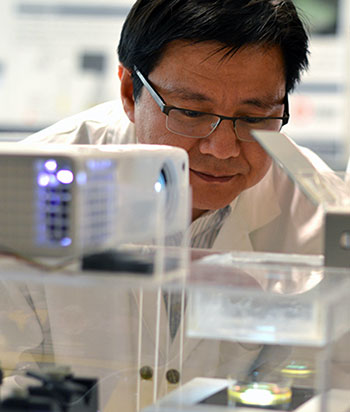UBC Okanagan prof. says the technique is a valuable new tool
Researchers from UBC’s Okanagan campus hope to make advances in tissue replacement and cancer research through a new technology that can produce living, 3D printed bio-tissues.
“One of the ultimate goals in biomedical engineering is to recreate viable, healthy and living tissues,” says engineering professor Keekyoung Kim. “The applications are staggering and could range from helping people suffering from ailments such as severe burns or organ failure to creating artificial tissues for research into diseases like cancer.”

Keekyoung Kim, associate professor at UBC Okanagan’s School of Engineering
Much like weaving a tapestry, Kim and his team devised a method of using an inexpensive laser diode to solidify a water-based gel into a complex cross-linked pattern. The engineered tissue provides not only strength but also a structure where living cells can live and thrive.
The new system, called direct laser bio-printing, is able to print artificial tissue at a much finer resolution than what’s currently possible and can support healthy, living cells with 95 per cent effectiveness.
“These findings show a promising future for tissue engineering and medical research,” says Kim. “We’re already looking at applying the technology to cancer research.”
According to Kim, there is considerable demand for biological models where researchers can grow cancer cells in three dimensions. He says that living cells are highly sensitive to chemical, mechanical, and biological conditions that are only present in a 3D environment.
Kim’s research, which was an interdisciplinary project from UBC Okanagan’s School of Engineering and Department of Chemistry, tested the artificial tissue’s ability to support healthy cells by building a pattern that encapsulated a commonly used line of breast cancer cells.
“The tissue pattern, which has extremely fine features and high cell viability, firmly demonstrates that our system has real potential to create functional, engineered tissue,” he says. “I’m excited by what this could bring to biomedical research.”
Kim worked with fellow engineering professor Jonathan Holzman and chemistry professor Fred Menard along with graduate students Zongje Wang and Xian Jin to develop the new system.
According to Holzman, this field of research is perfectly suited to interdisciplinary research.
"Bio-tissue printing applies knowledge in biology, chemistry, and microfabrication toward the health sciences,” says Holzman. “I think our recent success in bio-tissue printing came about from the multidisciplinary nature of our team."
The research, published recently in Advanced Healthcare Materials, was supported by Discovery Grants from the Natural Sciences and Engineering Research Council of Canada (NSERC) and the Canadian Foundation for Innovation John R. Evans Leaders Opportunity Fund.
About UBC's Okanagan campus
UBC’s Okanagan campus is an innovative hub for research and learning in the heart of British Columbia’s stunning Okanagan Valley. Ranked among the top 20 public universities in the world, UBC is home to bold thinking and discoveries that make a difference. Established in 2005, the Okanagan campus combines a globally recognized UBC education with a tight-knit and entrepreneurial community that welcomes students and faculty from around the world. For more visit ok.ubc.ca.
 Nearly $500K for car crash
Nearly $500K for car crash Mounties won't be charged
Mounties won't be charged Princess Anne visits BC
Princess Anne visits BC $36M for vaccine injury
$36M for vaccine injury  Canadians split on budget
Canadians split on budget Premier stands by pick
Premier stands by pick Car insurance fuels inflation
Car insurance fuels inflation Santos ends comeback bid
Santos ends comeback bid Douglas C-54 plane crashes
Douglas C-54 plane crashes US TikTok ban sent to Biden
US TikTok ban sent to Biden Phish fans enter the Sphere
Phish fans enter the Sphere CN Rail profits fall
CN Rail profits fall  Warriors snakebitten in loss
Warriors snakebitten in loss Iginla off to Europe
Iginla off to Europe Rockets ink prospect
Rockets ink prospect Alleged Tupac killer in court
Alleged Tupac killer in court Lawsuit accuses Megan
Lawsuit accuses Megan Bam Margera’s tour axed
Bam Margera’s tour axed



